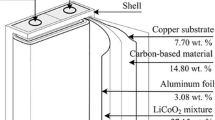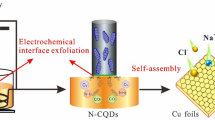Abstract
In this article, CuCl crystal was extracted from the waste copper etchant via one-step facile electrodeposition and further modified with graphene quantum dots (GQDs) via the electrophoretic deposition. Moreover, the feasibility as the anode in lithium ion battery was also evaluated. As expected, the obtained CuCl crystal particles appeared as the tetrahedron-like morphology, and the surface became rougher after modification of GQDs via the electrophoretic deposition. The reversible specific discharge capacity of GQDs/CuCl/Cu anode was 345.0 mAh·g−1 at 2.0 C for 250 cycles, higher than 284.6 mAh·g−1 of bare CuCl anode possibly owed to higher electric conductivity and Li-storage activity of GQDs. Obviously, such efforts would alleviate the environmental pollution and facilitate the circular economy of the waste copper etchant.










Similar content being viewed by others
References
Ming Z, Xiu F, Rovetta A, Qi H, Vicentini F, Bingkai L, Giusti A, Yi L (2009) Municipal solid waste management in Pudong new area China. Waste Manage 29:1227–1233
Seng B, Kaneo HK, Hirayama K, Katayama HK (2010) Municipal solid waste management in Phnom Penh, capital city of Cambodia. Waste Manage Res 29:491–500
Geng Y, Doberstein B (2008) Developing the circular economy in China: challenges and opportunities for achieving “leapfrog development.” Int J Sustain Dev World Ecol 15:231–239
Huang K, Guo J, Xu Z (2009) Recycling of waste printed circuit boards: a review of current technologies and treatment status in China. J Hazard Mater 164:399–408
Ni HG, Zeng EY (2009) Law enforcement and global collaboration are the keys to containing e waste tsunami in China. Environ Sci Technol 43:3991–3994
Kobayashi T, Kano K, Suzuki T (2011) A novel technology for on-site cupric oxide recovery from cupric chloride etchant waste. Water Sci Technol 64:416–422
Almeida C, Bonilla S, Giannetti B, Huisingh D (2013) Cleaner production initiatives and challenges for a sustainable world: an introduction to this special volume. J Clean Prod 47:1–10
Hadi P, Xu M, Lin CSK, Hui CW, Mckay G (2015) Waste printed circuit board recycling techniques and product utilization. J Hazard Mater 283:234–243
Wäger P, Hischier R, Eugster M (2011) Environmental impacts of the Swiss collection and recovery systems for waste electrical and electronic equipment (WEEE): a follow-up. Sci Total Environ 409:1746–1756
Kobayashi T, Kano K, Suzuki T, Kobayashi A (2011) A novel technology for on-site cupric oxide recovery from cupric chloride etchant waste. Water Sci Technol 64:416–422
Yang C, Li J, Tan Q, Liu L, Dong Q (2017) Green process of metal recycling: co-processing waste printed circuit boards and spent tin stripping solution. ACS Sustain Chem Eng 5:3524–3534
Lee MS, Ahn JG, Ahn JW (2003) Recovery of copper, tin and lead from the spent nitric etching solutions of printed circuit board and regeneration of the etching solution. Hydrometallurgy 70:23–29
Ogunniyi IO, Vermaak MKG (2009) Investigation of froth flotation for beneficiation of printed circuit board comminution fines. Miner Eng 22:378–385
Huang Z, Xie F, Ma Y (2011) Ultrasonic recovery of copper and iron through the simultaneous utilization of printed circuit boards (PCB) spent acid etching solution and PCB waste sludge. J Hazard Mater 185:155–161
Sze YKP, Wong JC (1994) A study of a solvent extraction method for the regeneration of ammoniacal etching solutions of copper. Environ Technol 15:785–793
Lee JC, Zhu T, Jha MK, Kim SK, Yoo KK, Jeong J (2008) Solvent extraction of Cu(I) from waste etch chloride solution using tributyl phosphate (TBP) diluted in 1-octanol. Sep Purif Technol 62:596–601
Yang Z, Huang C, Ji X, Wang Y (2013) A new electrolytic method for on-site regeneration of acidic copper (II) chloride etchant in printed circuit board production. Int J Electrochem Sci 8:6258–6268
Oxley JE (1995) Electrolytic regeneration of acid cupric chloride etchant, US Patent US5421966A
Yang Q, Kocherginsky N (2006) Copper recovery and spent ammoniacal etchant regeneration based on hollow fiber supported liquid membrane technology: from bench-scale to pilot-scale tests. J Membr Sci 286:301–309
Mdlovu NV, Chiang CL, Lin KS, Jeng RC (2018) Recycling copper nanoparticles from printed circuit board waste etchants via a microemulsion process. J Cleaner Prod 185:781–796
Liu S, Hou H, Liu X, Duan J, Yao Y, Liao Q, Li J, Yang Y (2017) Recycled hierarchical tripod-like CuCl from Cu-PCB waste etchant for lithium ion battery anode. J Hazard Mater 324:357–364
Natarajan G, Kumar RTR, Daniels S (2008) Electrical studies on sputtered CuCl thin films. J Mater Sci Mater Electron 19:103–106
Hajipour AR, Nazemzadeh SH, Mohammadsaleh F (2014) Choline chloride/CuCl as an effective homogeneous catalyst for palladium-free Sonogashira cross-coupling reactions. Tetrahedron Lett 55:654–656
Ames JR, Ryan MD, Kovacic P (1986) Mechanism of antibacterial action: electron transfer and oxy radicals. J Free Radicals Biology Medicine 2:377–391
Wang X, Luo N, Ying S (2000) Synthesis of SBS-g-PMMA with well-controlled branch chain by “living” radical polymerization. China Synth Rubber Industry 23:13–19
Sun HJ, Wu L, Wei WL, Qu XG (2013) Recent advances in graphene quantum dots for sensing. Mater Today 16:433–442
Kepic DP, Markovic ZM, Jovanovic SP, Perusko DB, Budimir MD, Holclajtner DI, Pavlovic VB, Todorovic-Markovic BM (2014) Preparation of PEDOT:PSS thin films doped with graphene and graphene quantum dots. Synth Met 198:150–154
Marković ZM, Labudová M, Danko M, Matijašević D, Mičušík M, Nádaždy V, Kováčová M, Kleinová A, Špitalský Z, Pavlović V, Milivojević DD, Medić M, TodorovićMarković BM (2020) Highly efficient antioxidant F- and Cl-doped carbon quantum dots for bioimaging ACS Sustain. Chem Eng 8(43):16327–16338
Stankovic N, Todorovic-Markovic B, Markovic Z (2020) Self-assembly of carbon-based nanoparticles films by Langmuir-Blodgett method. J Serb Chem Soc 85:1095–1127
He G, Song Y, Liu K (2013) Oxygen reduction catalyzed by platinum nanoparticles supported on graphene quantum dots. ACS Catal 3:831–838
Liu WE, Feng YK, Yan X (2013) Superior micro-supercapacitors based on graphene quantum dots. Adv Funct Mater 23:4111–4122
Liu WW, Yan X, Chen J, Feng Y, Xue Q (2013) Novel and high-performance asymmetric micro-supercapacitors based on graphene quantum dots and polyaniline nanofibers. Nanoscale 5:6053–6062
Gupta V, Chaudhary N, Srivastava R, Sharma GD, Bhardwaj R, Chand S (2011) Luminscent graphene quantum dots for organic photovoltaic devices. J Am Chem Soc 133:9960–9963
Zhao J, Chen G, Zhu L, Li G (2011) Graphene quantum dots-based platform for the fabrication of electrochemical biosensors. Electrochem Commun 13:31–33
Dong Y, Shao J, Chen C, Li H, Wang R, Chi Y, Lin X, Chen G (2012) Blue luminescent graphene quantum dots and graphene oxide prepared by tuning the carbonization degree of citric acid. Carbon 50:4738–4743
Ananthanarayanan A, Wang XW, Routh P, Sana B, Lim S, Kim DH, Lim KH, Li J, Chen P (2014) Facile synthesis of graphene quantum dots from 3D graphene and their application for Fe3+ sensing. Adv Funct Mater 24:3021–3026
Wang G, Guo Q, Chen D, Liu Z, Zheng X, Xu A (2018) Facile and highly effective synthesis of controllable lattice sulfur-doped graphene quantum dots via hydrothermal treatment of durian. ACS Appl Mater Interf 10:5750–5759
Wang JL, Xu CC, Lv GC (2016) Formation processes of CuCl and regenerated Cu crystals on bronze surfaces in neutral and acidic media. Appl Surf Sci 252:6294–6303
Lee CH, Hyun CY, Lee JH (2019) Deposition of pure Cu films on glass substrates by decomposition of Cu complex pastes at 250 °C and additional Cu plating, Appl. Surf Sci 473:359–365
Park J, Moon J, Kim C, Kang J (2016) Graphene quantum dots: structural integrity and oxygen functional groups for high sulfur/sulfide utilization in lithium sulfur batteries. NPG Asia Materi 8:272–282
Yu C, Hou H, Liu X, Yao Y, Liao Q, Dai Z, Li D (2018) Old-loofah-derived hard carbon for long cyclicity anode in sodium ion battery. Int J Hydrogen Energy 43:3253–3260
Marković ZM, Jovanović SP, Mašković PZ, Mojsin MM, Stevanović MJ, Danko M, Mičušík M, Jovanović DJ, Kleinová A, Špitalský Z, Pavlović VB, TodorovićMarković BM (2019) Graphene oxide size and structure pro-oxidant and antioxidant activity and photoinduced cytotoxicity relation on three cancer cell lines. J Photochem Photobiol B Biol 200:111647–111656
Hou HY, Dai ZP, Liu XX, Yao Y, Liao QS, Yu CY, Li DD (2018) Reutilization of the expired tetracycline for lithium ion battery anode. Sci Total Environ 630:495–501
Liu S, Hou HY, Hu W, Liu XX, Duan JX, Meng RJ (2016) Binder-free integration of insoluble cubic CuCl nanoparticles with a homologous Cu substrate for lithium ion batteries. RSC Adv 6:3742–3747
Park SK, Jin A, Yu SH (2014) In situ hydrothermal synthesis of Mn3O4 nanoparticles on nitrogen-doped graphene as high-performance anode materials for lithium ion batteries. Electrochim Acta 120:452–459
Brezesinski T, Wang J, Tolbert SH, Dunn B (2010) Ordered mesoporous α-MoO3 with iso-oriented nanocrystalline walls for thin-film pseudocapacitors. Nature Mater 9:146–151
Augustyn V, Come J, Lowe MA, Kim JW, Taberna PL, Tolbert SH, Abruña HD, Simon P, Dunn B (2013) High-rate electrochemical energy storage through Li+ intercalation pseudocapacitance. Nature Mater 12:518–522
Funding
This work was financially supported by the National Natural Science Foundation of China (Grant No. 51566006) and the 19th Young Academic and Technical Leaders of Yunnan Province (1097–10978240).
Author information
Authors and Affiliations
Corresponding author
Additional information
Publisher's note
Springer Nature remains neutral with regard to jurisdictional claims in published maps and institutional affiliations.
Rights and permissions
About this article
Cite this article
Hou, H., Lan, J., Zhu, J. et al. Extraction of tetrahedral CuCl anode from the waste copper etchant and surface modification with graphene quantum dots. Ionics 27, 4383–4391 (2021). https://doi.org/10.1007/s11581-021-04187-7
Received:
Revised:
Accepted:
Published:
Issue Date:
DOI: https://doi.org/10.1007/s11581-021-04187-7




